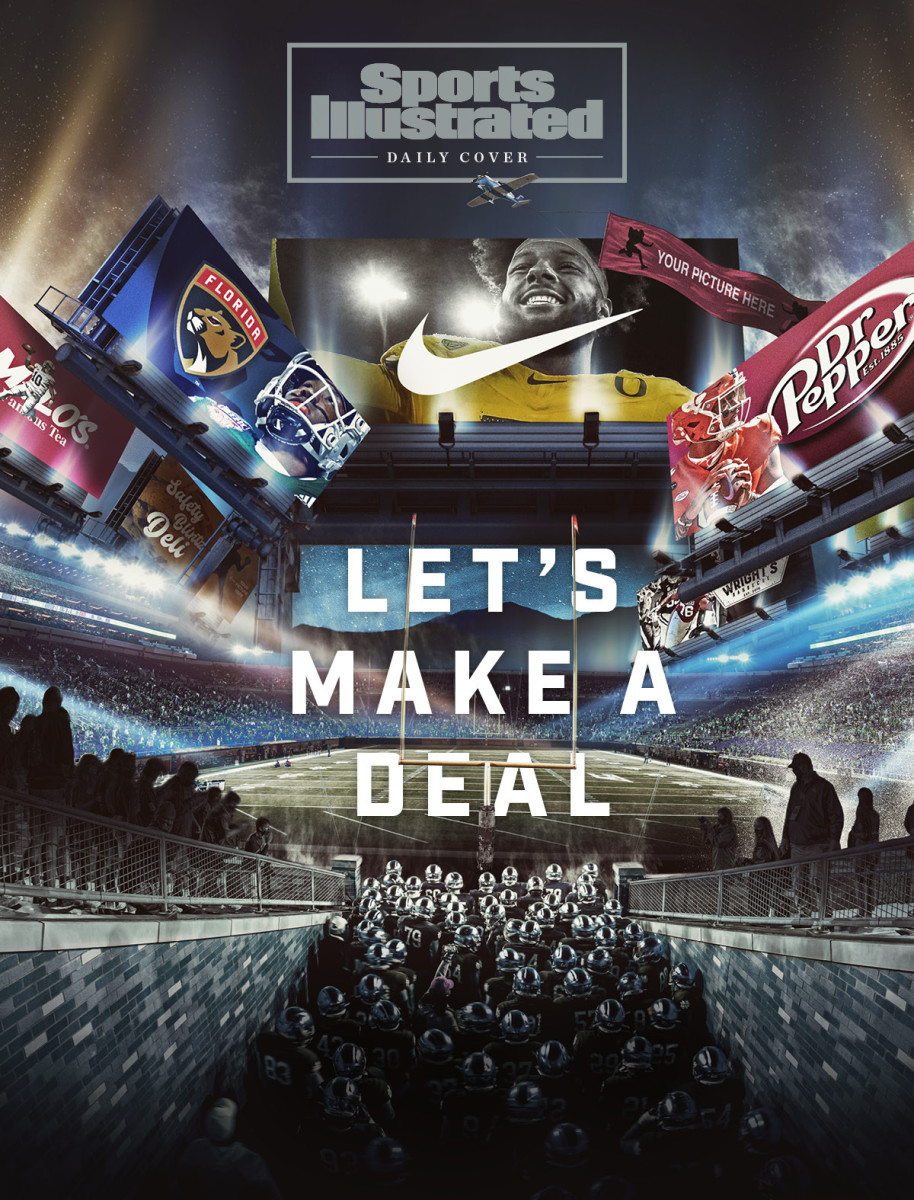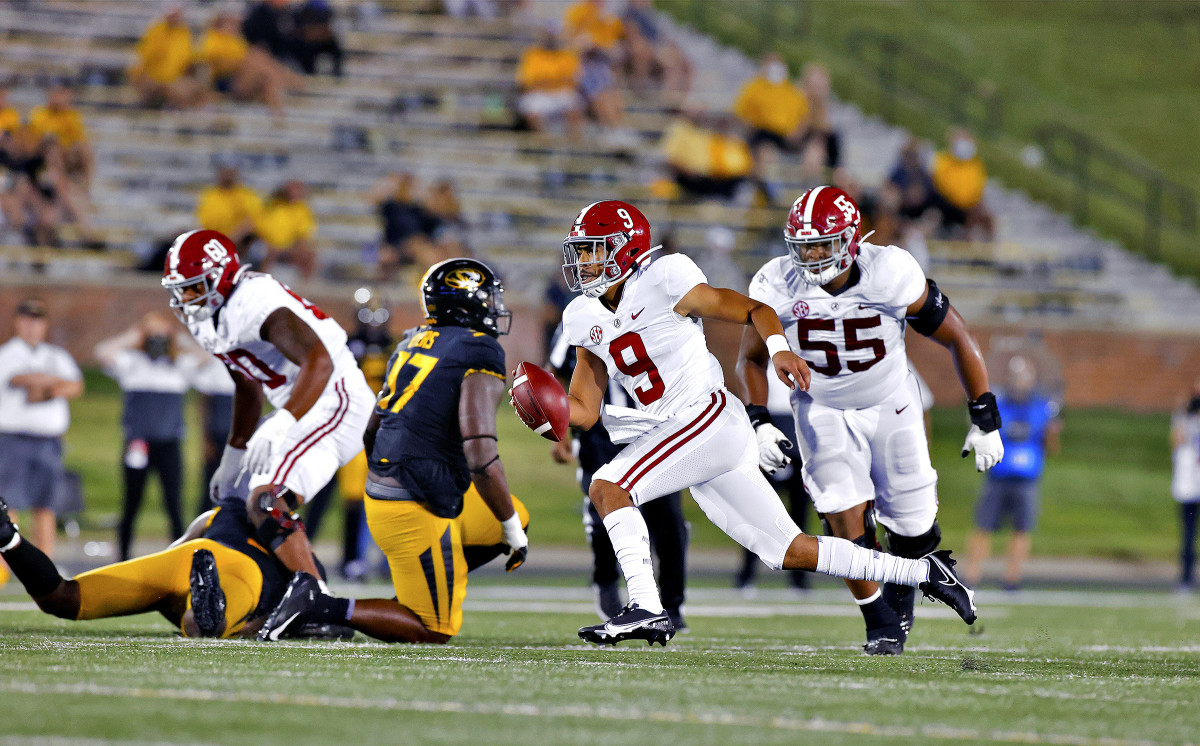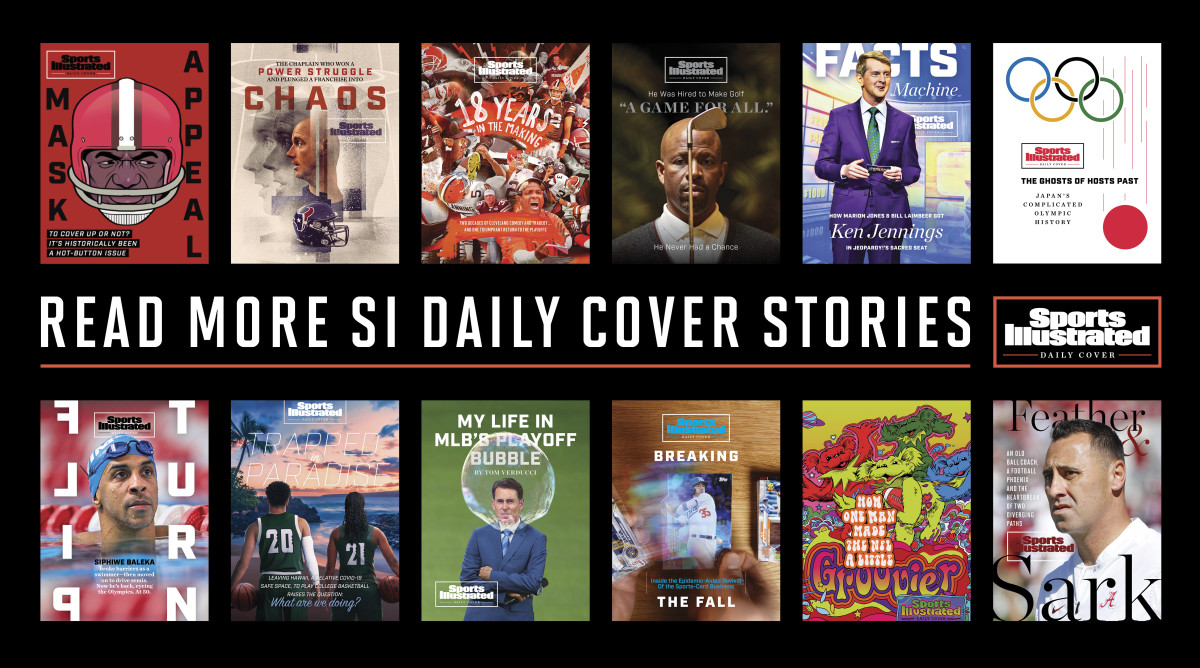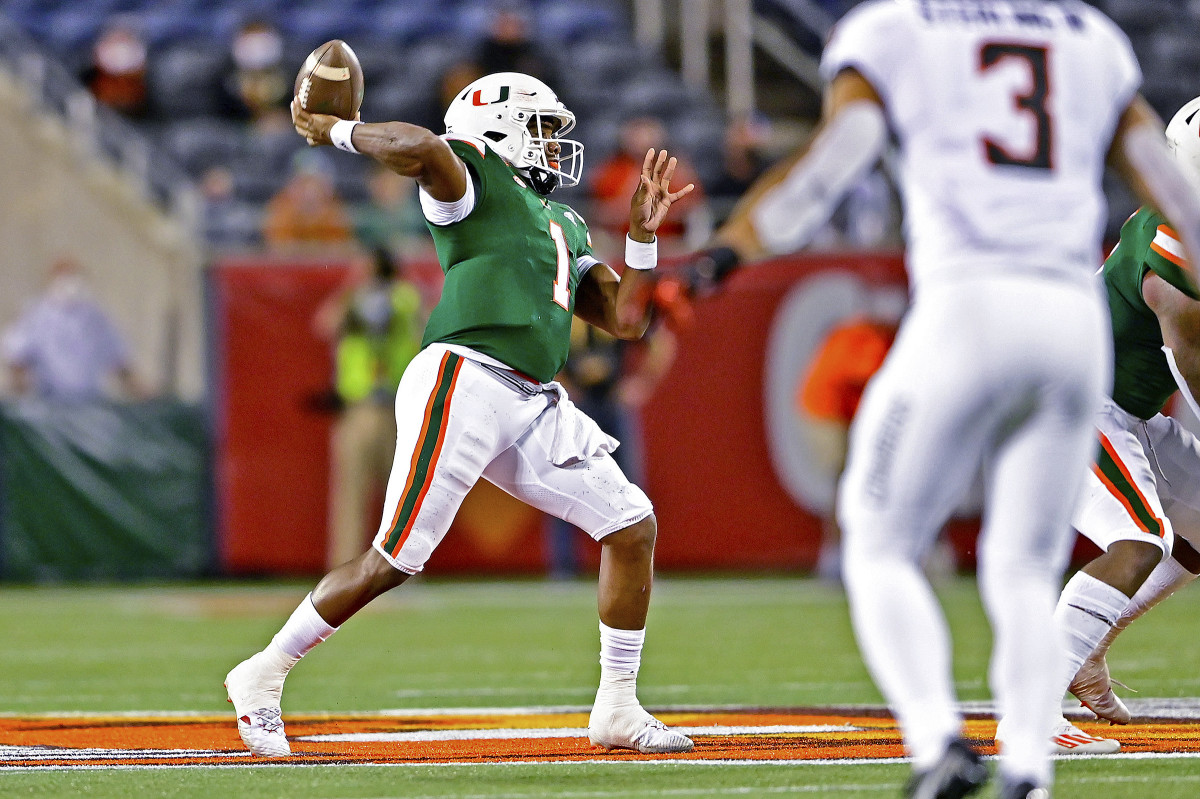The First Thing to Understand About NIL Is That Nobody Fully Understands NIL
In Baton Rouge, inside the club level of LSU’s colossal football stadium, coach Ed Orgeron delivered a message in late July to hundreds of influential businesspeople gathered to hear him discuss the 2021 Tigers.
His message was something no coach would have uttered publicly six months ago. “We’re paying players now: name, image and likeness,” he said. “So if you guys wanna start paying our players, you can go ahead!”
A week earlier in San Antonio, speaking at the state’s annual high school coaches convention, Alabama coach Nick Saban told a crowd of thousands that his sophomore quarterback, Bryce Young, who hasn’t yet started a single game, was approaching $1 million worth of endorsements.

In Columbus, the nation’s top prospect for 2022, quarterback Quinn Ewers, arrived at Ohio State after skipping his senior season at Carroll High in Southlake, Texas, so he could immediately start earning endorsements.
And in Miami, a Hurricanes supporter promised each scholarship football player a monthly check of $500 if they endorsed his business, a chain of mixed martial arts gyms.
Indeed, a new era in college football is upon us. Now more than ever—or at least now more transparently than ever—the competition on the field will be decided by which programs are best able to help their players cash in off it.
“It [will be] a $1 billion–a-year industry, at least,” says Blake Lawrence, the CEO and founder of Opendorse, a sports tech company that helps match players with name, image and likeness (NIL) opportunities. “It’s coming and it’s going to be huge.”
In just a few months, NIL has altered the college sports landscape, disrupting a foundation of (nominal) amateurism that had stood for a century. While athletes are benefiting, administrators and coaches are scrambling to understand the concept, regulate it and use it to their own advantage.

The first thing to understand about NIL is that nobody fully understands NIL. For decades, college athletes were not allowed to profit off their images. Then, last year, a patchwork of states began passing laws—all somewhat different from each other—mandating that they be permitted to. The NCAA urged Congress to pass a uniform set of rules, but no such help was forthcoming. And so, with the state laws about to go into effect, the NCAA threw the doors wide open, saying that, effective July 1, all athletes could benefit from their name, image and likeness. As if begging Congress to come to its regulatory rescue, the NCAA kept the rules vague: It has released guidelines stating only that schools cannot facilitate NIL ventures for athletes and that athletes cannot strike deals that are built around pay-for-play. Everything else is up to interpretation.
Some schools are operating under state laws that mandate additional rules. For instance, states like Texas and South Carolina specifically bar athletes from using their school’s marks in NIL deals. Other states’ laws don’t address the issue. Meanwhile, schools operating in states without laws get to make up their own playbooks (and, as we’ll see, whether to allow athletes to use those school marks is among the most consequential decisions they face).
Midnight on July 1 was met with a flurry of deals. Since then, overwhelmed school compliance staffs have been fielding up to 200 inquiries from players per day.
Between the NCAA’s hands-off approach and a lack of clarity around how state laws will be enforced, the schools are policing themselves. Creative interpretation of the NCAA guidelines is not only expected, but it’s also already happening. And it’s not difficult. As long as there is a documented exchange between an athlete and a business, it passes muster for not being facilitated by the school. If a restaurant wants to give an offensive lineman free meals for a year for tweeting an endorsement, it’s fine. If a local shoe store wants to pay a quarterback $10,000 a year to wear its cleats once, it’s cool.
“It’s pretty much a free-for-all,” says Tom McMillen, the CEO of Lead1, which represents the athletic directors of the Football Bowl Subdivision.
For years, most coaches fought against allowing athletes to be compensated for their likeness—an American right that every other college student holds. Now they have suddenly joined the chorus of change, crowing about their players’ deals, honing recruiting pitches and, some of them at least, publicly encouraging their supporters to pony up.
After all, NIL has evolved into the newest snazzy tool to woo young athletes, another question for recruits to ask.
How grand are your facilities?
How storied is your football tradition?
How many players do you send to the NFL?
How much money can I earn at your school?
“We use it,” says USC coach Clay Helton. “We have a presentation we do in recruiting to be able to show the advantages of being in a market like L.A.”
The Trojans signed the seventh-ranked recruiting class this past year, according to 247Sports’ composite list. “A big piece of it was NIL,” says USC director of player personnel Spencer Harris, who oversees the program’s 30-minute NIL pitch to prospects. “It’s a part of every recruiting conversation at every school.”
Athletes are cashing in at a rate that even experts didn’t expect. Lawrence believes the enterprise will exceed $1.5 billion annually if all athletes were to participate. He estimates that just 10% of college athletes did so in NIL’s first month.
For now, football is king. While most NIL transactions are in the double or triple figures, big-money deals from the top percentiles are inflating averages. For example, in July, the average transaction on INFLCR, one of the largest NIL platforms, was $923. Yet the median deal was for a mere $25, says Jim Cavale, INFLCR’s CEO.
A similar disparity exists in total NIL compensation. One unnamed athlete made $210,000 in July from their NIL ventures struck on Opendorse. However, the average Division I athlete on the platform in July made $471, and the monthly median figure was just $35.
On Opendorse, the most-used avenue for NIL is social media promotions, accounting for 88.5% of all transaction activity but just 46% of total money. That’s because nearly one-third of NIL revenue was derived from companies using a player’s likeness in endorsement or commercials. By sport, football players made up 79% of the NIL market shares on the platform, followed by men’s basketball (9.6%) and women’s volleyball (5.5%).
Those numbers paint only a partial picture. While Opendorse and INFLCR combined to cover more than 4,000 college athletes, thousands more are sprinkled across a bevy of smaller, more local digital marketplaces. There’s another group, too: Athletes with enough cachet have hired reps to help them strike bigger deals.
More than 100 college football players have signed with marketing agents or agencies, says Darren Heitner, a Florida-based sports lawyer and himself counsel for some college athletes. “Many new agencies have sprouted up. All of a sudden they’re becoming licensed—or not—and signing up players,” he says.
The majority of NIL deals feature a small payment for an athlete’s endorsement on social media. Wright’s Barbecue in Johnson, Ark., for example, struck deals with several Razorbacks linemen. As the 6' 9", 330-pound tackle Dalton Wagner tweeted, “No one knows quality BBQ like an OLineman!” Some brands have targeted quantity, striking agreements with thousands of athletes across a variety of sports. For example, Barstool Sports offered $100 of free apparel for any athlete who added the company’s name to their social media bio. According to Lawrence, more than 130,000 athletes have participated.
However, small-dollar deals aren’t going to move the recruiting needle. So what is? Experts say three things are emerging in the NIL universe that could impact the recruiting landscape: (1) colicensing; (2) group licensing; and (3) community participation.

Colicensing entails schools granting permission to use their institutional marks, such as logos, emblems and color schemes. Some schools are barred by state law, but most are working on a case-by-case basis. Schools don’t make money here, but they allow a player to, say, wear his jersey in a car dealership ad to make himself more identifiable.
Some schools are going a step further, essentially becoming business partners with their players so that both sides profit: That’s group licensing, a strategy that, for instance, allows both schools and players to make money from jersey sales that—finally—feature players’ names.
Those schools are ahead of the game, says Casey Schwab, an ex–NFL Players Association executive and the CEO of Altius, an NIL consulting company. “It’s one thing to say as a school that you support athletes in NIL deals,” Schwab says. “They are putting their money where their mouth is.”
Ohio State, Alabama and North Carolina became three of the first programs to partner with a third party, the Brandr Group, a brand management and licensing agency, in a three-way deal that allows athletes to earn compensation from jerseys and other merchandise outfitted with school logos and their names or likenesses.
Syracuse partnered with star guard Buddy Boeheim, son of legendary coach Jim, on apparel that features his own personal logo—a silhouette of Buddy, midshot—accompanied by the school’s block S. The reveal of the apparel shook administrators who are apprehensive about athletes using school marks because they believe the practice will impact their contracts with trademark licensing companies that pay schools millions annually for the right to those marks. “Some universities are scared of it,” says Syracuse director of compliance Mark Wheeler, who helped orchestrate Boeheim’s deal. “We viewed it as more of a positive.”
Syracuse deputy athletic director Andrew Goodrich says that he already hears prospects asking the question: Will I be able to use school marks? The issue is big enough for athletes that in August, Michigan coach Jim Harbaugh brought the chairman of the school’s board of regents to practice to inform players that they could, in fact, use UM’s block M logo in their own commercial transactions. In a video posted on social media, the team roared its approval.
Dan Gale, president of the college athletics consulting firm Leona Marketing Group, says the first few weeks of NIL have shown that 99% of college athletes don’t possess a strong enough brand to strike significant deals. They need the school’s marks to elevate their NIL futures.
But schools are all over the map, says INFLCR’s Cavale. “You have schools granting the marks and other schools that don’t want them even using the colors,” he says.
At many schools, athletes donning school logos are participating in NIL activities without seeking permission. School licensing companies, which thought they had exclusive rights to those logos, have even intervened, requesting that the material be removed. It’s a complicated issue, but whoever figures out the process best will hand to their coaches recruiting “talking points,” says Schwab.
Some coaches already seem prepared. With his statement in late July, Orgeron may have jump-started NIL movement from his local businesses.
The biggest NIL advantage isn’t necessarily in a school’s size and tradition, but the participation of its business community, says Henry Hays, founder and chairman of MatchPoint Connection, a digital marketplace based in Baton Rouge. “Does this just benefit the big schools? I’m not sure that’s right,” Hays says. “If you have a school with less resources but their community is set up to have these discussions, they’re in a better spot.”
Dan Morgan, an Orlando-based lawyer and NBA agent who has also served as an adviser for college athletes, says he’s already learned about schools strongly encouraging their boosters to purchase their athletes’ Cameo spots or buy apparel.
But there are bigger plans afoot: Remember the Miami gym owner promising to give each Hurricanes player $500? That deal alone has already rattled enough cages that one industry executive expects supporters of other programs to return fire. He says boosters elsewhere have suggested paying their schools’ athletes not $500 monthly, but $5,000. Already, Built Brands, a protein bar company in Utah, offered $1,000 annual endorsement deals to each BYU scholarship football player, while also striking deals with walk-ons for amounts that cover their tuition.
The man behind the Miami gym offer, Dan Lambert, has also started a company whose sole purpose is raising money from fans—say through a ticketed party or event—and then donating that money to local businesses willing to use it to hire Miami athletes as endorsers. And if Lambert’s new company proves successful, it is sure to inspire others. His plan seems to be in accordance with Florida’s NIL law, and he says he cleared it with Miami.
“What’s the downside in being aggressive here?” McMillen asks. “You can speed down the highway and not get pulled over.”
One agent told Sports Illustrated that he has advised his coaching clients to facilitate NIL contracts for athletes and recruits with local businesses. That technically could run afoul of the NCAA guidelines, but who’s to stop them?

Among coaches, the lack of clear rules is a concern, says Todd Berry, the executive director of the American Football Coaches Association. He believes college football is headed toward a place it’s already been—the scandal-ridden, rule-breaking days of the 1970s and ’80s.
“It’s going to come down to an arms race on how much money you can raise to pay players,” says Berry. (This is, of course, good for players.)
Coaches are even poking one another publicly over NIL recruiting tactics. In late July, Stanford coach David Shaw made pointed comments about Saban’s address at the Texas high school coaches association, suggesting it was nothing more than a recruiting maneuver.
“It wasn’t accidental,” Shaw says. “Many of us around college football shrugged our shoulders and said, ‘Is this really what we want to be doing?’ ”
In the meantime, those within the NIL industry chalk up another win for Saban’s Tuscaloosa-based dynasty.
“Alabama got an early NIL lead, as if it needed it,” says Heitner.
Another issue arising: Lawrence estimates that only half the national NIL transactions are being disclosed to schools, one of the only requirements of athletes.
It’s another speed bump that could be smoothed out with congressional action, some believe. On Capitol Hill, Representative Colin Allred (D., Texas), a former Baylor football player, says lawmakers are hearing from their state university administrators about the imbalance across the country. From the lack of enforcement to the issues with boosters, athletic officials are loudly encouraging Congress members—after previous failed attempts—to pass legislation that would provide a universal policy and an enforcement arm.
Allred believes a national standard will eventually pass, but it could be next year. “Everybody is looking at the recruiting impact of this and the role boosters will play in this. That’s a big concern,” he says.
A federal standard could help solve two other lingering issues. There is uncertainty around both the NIL rights of high school athletes and international college athletes. Most high school associations have not yet allowed prep stars to profit from NIL. International college athletes on student visas are not allowed to earn compensation.
Meanwhile, some of the biggest brands in the country—Gatorade, McDonald’s, Degree deodorant and Pepsi—are expected to begin creeping into the NIL space soon. While Nike agreed to a reported six-figure memorabilia deal with Oregon edge rusher Kayvon Thibodeaux, no other household brands had entered the NIL arena in its first six weeks, until Aug. 11, when Clemson quarterback D.J. Uiagalelei struck a deal with Dr Pepper to star in the company’s latest national college football ad campaign (sans official orange jersey, of course).
He’s believed to be the first college football player to be featured in a national television commercial in the NIL era, a point likely to be repeated frequently by Clemson coaches on the recruiting trail.
“In two to three years, I think it’s going to gain real traction,” says Syracuse’s Buddy Boeheim. “For some colleges, there’s a huge market. Down the road, it can really blow up. Who knows where it can lead to?”
